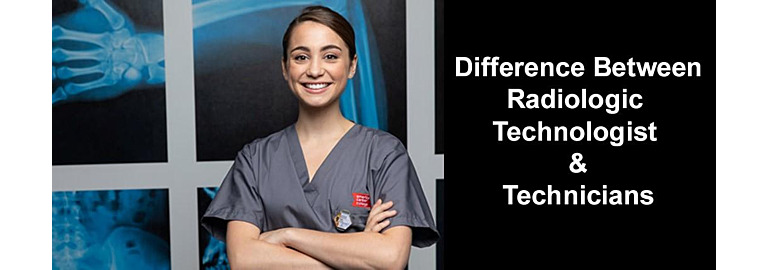The Difference Between Radiologic Technologists and Radiologic Technicians
Radiologic technologists and technicians both work in the field of Radiology, but the training and responsibilities are very different. Both professions involve working with patients and performing an imaging procedure, but technologists have more education and take on more responsibilities than radiologic technicians do.
Radiologic Technologist
Radiologic technologists are expected to earn an Associate degree at a two-year program from an accredited educational institution. Many accredited programs require certain pre-requisite college classes to be completed before even applying to the radiology program. Technologists are licensed by the ARRT (American Registry of Radiologic Technologists.) as well as licensed in the state in which they work. This ensures that the Technologists has accurately completed a rigorous accredited program and understands the dangers and bioeffects of giving radiation to a patient. They perform general radiographic examinations on all body organs, systems, and structures. They are required to show clinic competency to meet all the required state licensure and certification requirements. Technologists are often in charge of the imaging machinery at their hospital or clinic. They maintain the equipment, make minor adjustments and report problems to the proper channels. Technologists follow the orders of a physician for imaging exams and document information that is pertinent to the patient in the medical record. They have training and experience to talk with patients before imaging procedures and answer questions as it relates to the exam requested as well as protect patients from unnecessary radiation exposure. They have a sturdy background and experience of technical skills mixed with human empathy to obtain the most diagnostic image possible. They also have the opportunity to cross train into other modalities like CT, MRI, Ultrasound, Interventional, Nuclear Medicine and Mammography.
Radiologic Technician
Technicians need a high school diploma and get on-the-job training from a vocational school and work experience. Their work in radiology is limited to only what they have been trained to perform. They are often called Limited License Technicians because they have demonstrated competency in performing a specific examination of a certain anatomical region and have received a limited license or certification. Most states require attendance at a limited licensure school and passing the state limited permit examination.
I hope that this has helped clear up any difference between Technologists and Technicians. If you want to learn more about becoming an X-Ray Technologist, please visit the American Registry of Radiologic Technologists the leading credentialing organization for Radiologic Technologists. Here you will learn more about what Technologists do, where to find educational programs and learn more about careers and professional societies. Z&Z Medical is proud to support those who image patients every day. Visit www.ZZMedical.com to learn more about the imaging accessories and supplies that can make your day to day job easier!

